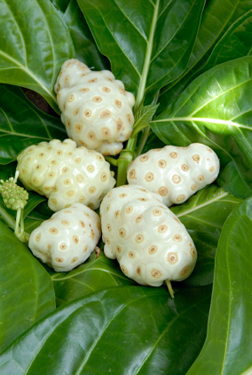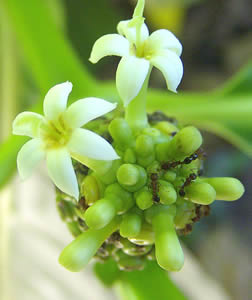Noni Morinda citrifolia

Noni fruits and leaves
- Common Names
- Noni , Indian Mulberry, Mengkudu, Nono, Nhau, Ashyuka.
- Botanical Name
- Morinda citrifolia
- Family
- RUBIACEAE
Medicinal Uses & Benefits of Noni
![]() How to Use|
Side Effects |
Plant & Garden|
How to Use|
Side Effects |
Plant & Garden|
- Medicinal Uses: * Ayurvedic
* Immune
* Insect Repellent
* Nutrition
* Parasites/worms
* Polynesian
- Properties: * Analgesic * Antiparasite * Antirheumatic * Antiscorbutic * Cathartic * Febrifuge * Hypotensive * Immunostimulant * Vulnerary
- Parts Used: Pulp, juice
- Constituents: lignans, oligo- and polysaccharides, flavonoids, iridoids, fatty acids, scopoletin, catechin, beta-sitosterol, damnacanthal, and alkaloids
How to Use: Noni
Noni juice recently toped the list of best selling botanicals published by the Nutrition Business Journal, beating out such proven favorites as green tea and echinacea, which goes to show how much influence multi-level marketing can have on the health supplements field. While Noni juice is a new fad here on the mainland, the noni fruit has been a part of traditional Polynesian medicine for centuries. In Hawaii the traditional uses of noni include for cough, colds, pain, liver disease, malaria, hypertension, and intestinal worms. The fruit and juice were used in topical first aid applications to treat burns and cuts, swellings and to repel insects. Contemporary users have widened the uses of noni to an almost panacea status with claims that it can help everything from ADD to jet lag, but there is little to no evidence to support such claims. There has been some animal studies that show some promise in anti-tumor activity, more study is warranted, but the evidence for cancer claims is just not there as yet.2
Preparation Methods & Dosage :The powder taken in capsule form, the fresh juice is enjoyed locally.
Ayurvedic Medicine
 Noni was mentioned in Ayurvedic texts well over 1000 years ago as Ashyuka, which means longevity, and was used as a balancing agent. 1Many traditional noni users thought that the terrible taste and smell would drive away spirits, gods, and other agents that caused the illness. 2
Noni was mentioned in Ayurvedic texts well over 1000 years ago as Ashyuka, which means longevity, and was used as a balancing agent. 1Many traditional noni users thought that the terrible taste and smell would drive away spirits, gods, and other agents that caused the illness. 2
Noni Side Effects: None noted, but safe levels of use in pregnancy have not been established
Plant Description
- Flowers/Fruit/Seeds:Small white flower produces a pungent, oval fruit containing many seeds. The ripened fruit is pale yellow to offwhite and reaches almost 3 inches in size. The fruit is bitter, but edible, and is eaten as a staple by Pacific Islanders.
- Plant Class:Evergreen tree grows up to 30 feet in hight
- Rhizome:
- Leaves:large, simple, dark green, shiny and deeply veined leaves.
- Preferred Habitat:Volcanic slopes, sea shores, and forests
- Flowering Season:year-round
- Distribution:India, Pacific Islands with Tahiti being the dominant producers, Costa Rica, Barbados, Puerto Rico
Regional Traditions :Ayurvedic * Tropical islands *
- Mountain Rose Herbs
- American Botanical Council. Etkin N, McMillen H. "The ethnobotany of noni (Morinda citrifolia L., Rubiaceae." HerbalGram
The authors believe that it is illogical for noni to have such a diversity of uses, that scientific research has not corroborated any of these claims, and that much of noni's popularity is due to user testimonials which have built up consumer's confidence.












